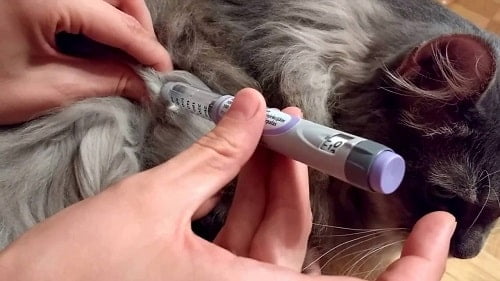What is Lantus (glargine insulin)?
It is a man-made insulin that is used to treat people with type 1 and type 2 diabetes. Lantus refers to the brand name of insulin glargine and is produced by Sanofi-Aventis. Insulin glargine mimics the natural hormone produced by the beta cells and is used to control blood glucose levels. When injected under the skin, insulin glargine works in the body by helping glucose enter the muscle cells, so it can be converted into energy. Lantus is a long-acting insulin, which means that it takes several hours before it starts to work to reduce blood sugar levels and keeps working for a longer period.
Lantus insulin for cats
Insulin glargine, which is commonly used to treat people with diabetes mellitus, can also be used to treat diabetic cats. Diabetes in cats refers to a condition where the pancreas cannot produce enough insulin or the cat’s body becomes resistant to insulin. As a result, diabetic cats have high levels of blood sugar. Insulin glargine helps to treat diabetic cats by normalizing the level of blood glucose. Controlling blood glucose in diabetic cats is important because it can help to prevent the risk of other medical complications. Lantus is a long-acting insulin that should be administered subcutaneously using a syringe.
Cats usually have a faster glucose metabolism hence they require long-acting insulin, such as Lantus, to help them regulate their blood sugar levels for up to 12 hours.
Some experts argue that because insulin glargine lasts for too long, it may cause an overlap in some diabetic cats. On the other hand, cat owners have complained that it is difficult to time the next insulin injection because the action of the drug stops abruptly. It is important to note that the action of insulin glargine depends on body chemistry of the cat.
Dosage
Before you start using Lantus to treat your diabetic cat, it is advisable you speak to your veterinarian. Your veterinarian will determine the dose and number of times you should inject this insulin every day. Normally, 2 injections per day offers better glycemic control compared to 1 dose per day. The dosage will depend on glucose concentration prior to using insulin glargine, daily water intake and glucose concentration in urine. Your veterinarian will discuss the best dose for your cat. You should not give your cat more than what is directed by your veterinarian. If you miss a dose, do not double the next dose. While using Lantus to treat diabetic cats, it is recommended you check their blood glucose frequently. This can be done at home or in a hospital. Unopened Lantus should be kept refrigerated. Opened vials should be stored under room temperature for 28 days. Do not refrigerate opened vials.
Side effects
Lantus is considered a safe drug for most diabetic cats. However, there are some side effects that have been reported as a result of using Lantus to treat diabetes in cats.
- Hypoglycemia
- Allergic reaction
Other side effects may occur. This medication can also lead to inflammation or irritation at the injection site. In case you notice unusual behavior or symptoms in your cat, you should contact your veterinarian immediately.
You can check Lantus insulin prices at canadianinsulin.com
Doctor’s Recommendation
While technically not qualified to comment on animals some general principles apply. Allow the veterinarian to determine the dose and frequency of Lantus. While technically, Lantus must be used within 28 days, it is reasonable to keep using the insulin and verifying its efficacy as, in actuality, there may be a slight difference in clinical efficacy. In general, medications last longer in the refrigerator.
Disclaimer: Please note that the contents of this community article are strictly for informational purposes and should not be considered as medical advice. This article, and other community articles, are not written or reviewed for medical validity by Canadian Insulin or its staff. All views and opinions expressed by the contributing authors are not endorsed by Canadian Insulin. Always consult a medical professional for medical advice, diagnosis, and treatment.



